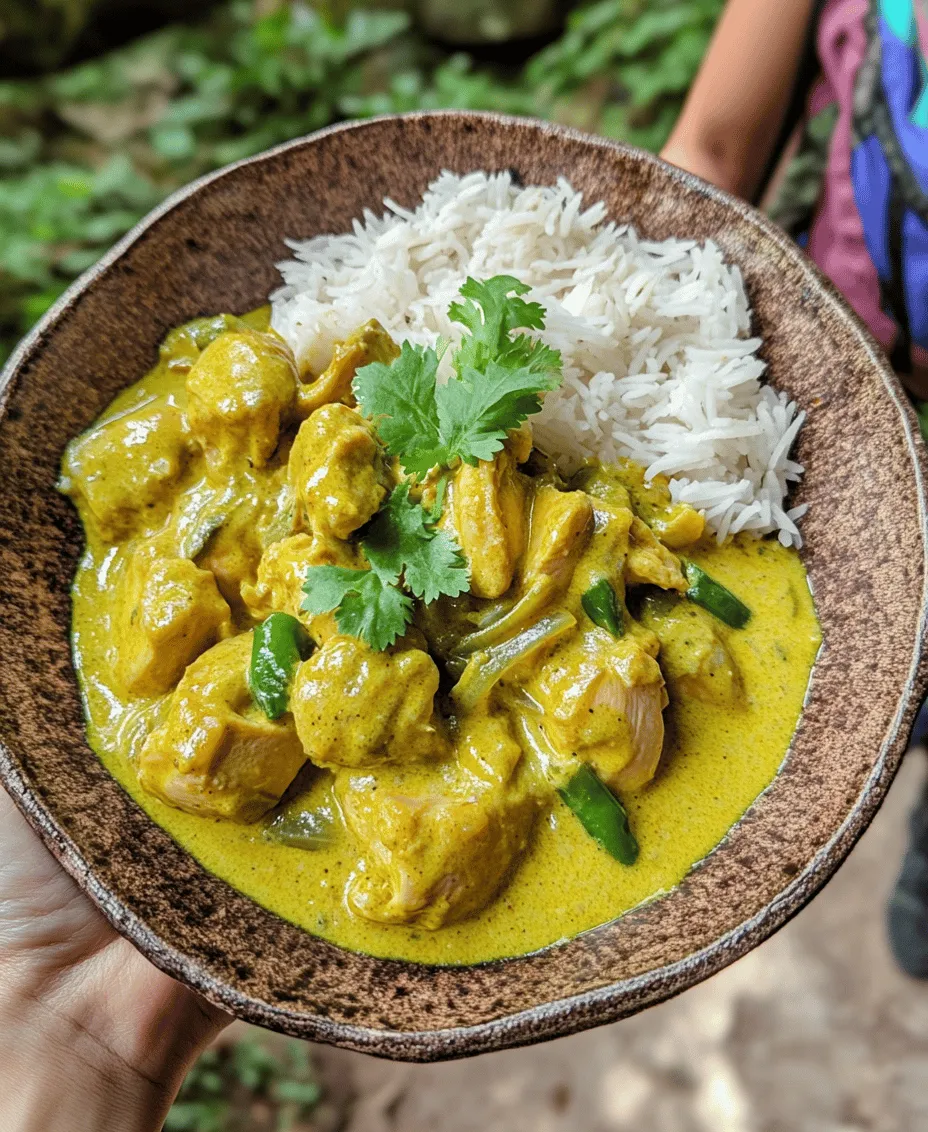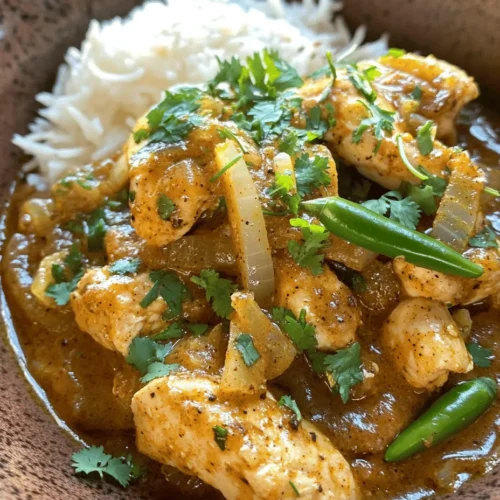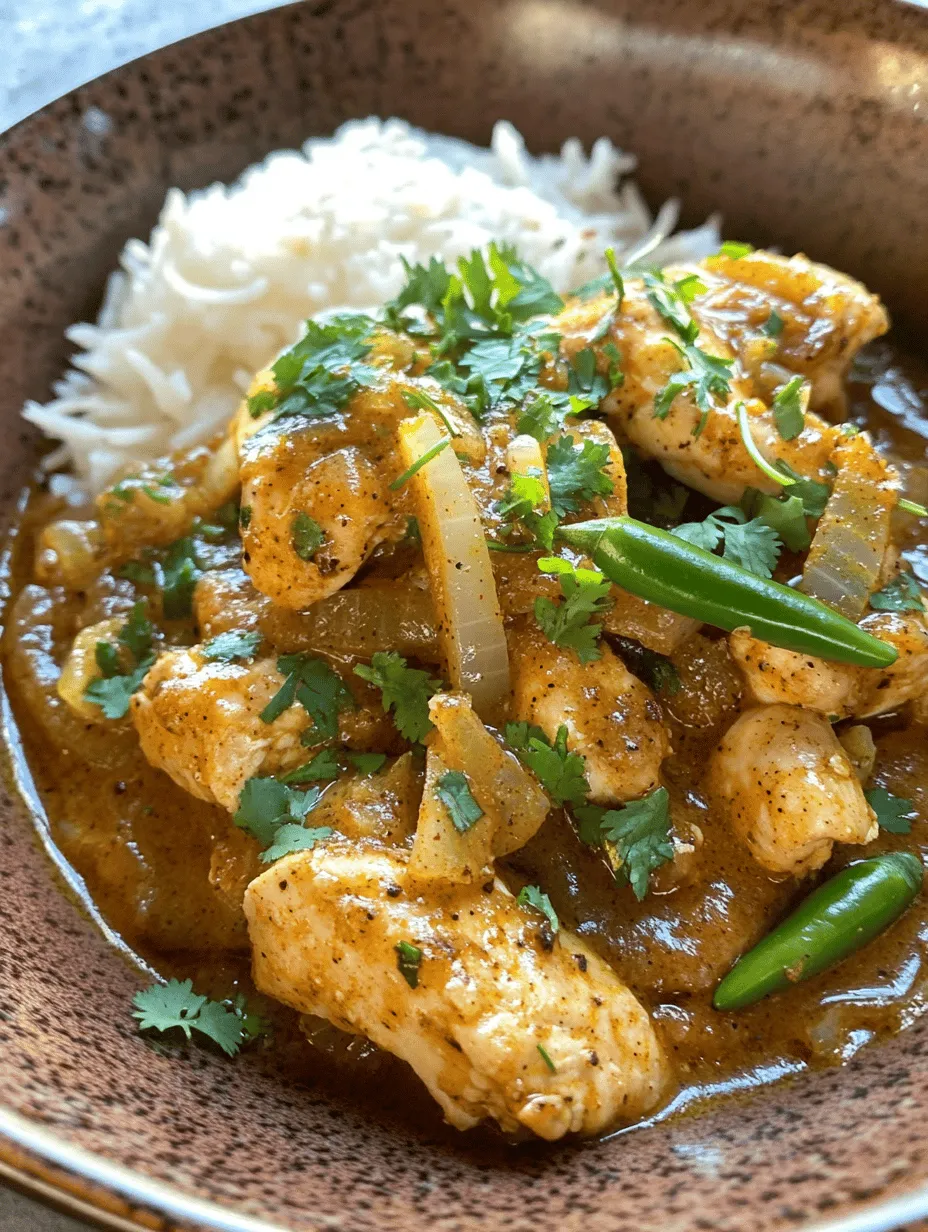Kuku Paka is a tantalizing dish that hails from the vibrant culinary landscape of East Africa, particularly popular in regions like Kenya and Tanzania. This delightful chicken curry boasts a rich and creamy texture, thanks to the inclusion of coconut milk, which is a staple in many coastal East African cuisines. The name “Kuku Paka” translates to “chicken in coconut,” perfectly encapsulating the essence of this dish. Originating from the Swahili coastal culture, Kuku Paka has been a beloved meal for generations, often enjoyed during festive occasions and family gatherings. Its significance extends beyond mere sustenance; it represents a fusion of diverse cultures and flavors that have evolved through centuries of trade and migration along the East African coast.
As the culinary world becomes increasingly interconnected, Kuku Paka has garnered attention beyond its regional roots. Food enthusiasts and chefs from around the globe are embracing this dish, intrigued by its unique blend of spices and its comforting, flavorful profile. In recent years, Kuku Paka has found its way onto restaurant menus worldwide, celebrated for its aromatic spices and the creamy richness of coconut milk. This growing popularity speaks to the dish’s accessibility and the universal appeal of its flavors, making it a must-try for anyone looking to explore the depths of East African cuisine.
Understanding the Ingredients of Kuku Paka
To fully appreciate the depth of flavor and texture in Kuku Paka, it’s essential to understand the key ingredients that come together to create this delightful dish. Each component plays a vital role in building the unique profile that Kuku Paka is known for.
Key Ingredients and Their Roles
1. Chicken: The star of Kuku Paka is, of course, the chicken. Traditionally, bone-in pieces are preferred for their ability to absorb flavors and remain juicy during cooking. However, boneless chicken can also be used for convenience. The choice of chicken is crucial, as it acts as the canvas upon which the rich, aromatic flavors are layered.
2. Coconut Milk: This ingredient is the heart of Kuku Paka, providing creaminess and a subtle sweetness that balances the spices. Coconut milk is not only a common ingredient in East African cooking but also reflects the region’s tropical climate where coconuts thrive. Its inclusion elevates the dish by creating a luscious sauce that envelops the chicken, making each bite a comforting experience.
3. Spices: A blend of spices is essential for achieving the authentic flavor profile of Kuku Paka. Key spices include:
– Coriander: Adds a warm, citrusy flavor that enhances the overall taste.
– Cumin: Provides an earthy depth, complementing the other spices.
– Turmeric: This vibrant spice lends a beautiful golden color and a subtle bitterness that balances the dish.
– Garam Masala: A quintessential Indian spice mix that adds complexity and warmth.
4. Lime Juice: The addition of lime juice is vital for brightening the dish. It cuts through the richness of the coconut milk and chicken, providing a zesty finish that elevates the flavors.
5. Fresh Cilantro: This herb adds a fresh, vibrant note, enhancing the dish’s overall appeal. It’s often used as a garnish, offering a pop of color and a burst of freshness.
The Importance of Coconut Milk in East African Cooking
Coconut milk is a cornerstone of many East African dishes, particularly those from coastal regions. It not only contributes creaminess but also introduces a distinct flavor that is synonymous with tropical cuisine. The use of coconut milk in Kuku Paka reflects the cultural significance of coconuts in East African societies, where they are often associated with abundance and hospitality. This ingredient transforms the dish into a rich, flavorful experience, making it comforting and indulgent—a true reflection of East African culinary heritage.
Chicken Selection and Preparation
When preparing Kuku Paka, the selection of chicken is paramount. While bone-in pieces are traditionally favored for their flavor and moisture retention, boneless options can be convenient for a quicker cook time. Whichever cut you choose, ensuring that the chicken is fresh and of high quality will significantly impact the dish’s overall flavor. Additionally, marinating the chicken before cooking is a crucial step that enhances its taste and tenderness, allowing the spices and coconut milk to infuse deeply.
The Role of Spices: Building Flavor Complexity
The careful selection and use of spices are what truly set Kuku Paka apart. Each spice contributes to building layers of flavor, creating a harmonious balance in the dish. The warmth of coriander and cumin, the earthiness of turmeric, and the complexity of garam masala combine to create a symphony of taste that is both comforting and exotic. The timing of spice incorporation is also vital; adding them at different stages of cooking can enhance their flavors and aromas, ensuring that each ingredient shines through.
The Significance of Lime Juice and Fresh Cilantro
Incorporating lime juice into Kuku Paka serves more than just a flavor-enhancing purpose; it acts as a balancing agent against the richness of the coconut milk and the spices. The acidity from lime juice cuts through the heaviness, adding brightness to each bite. Similarly, the fresh cilantro not only garnishes the dish but also elevates its flavor profile, providing a refreshing contrast to the rich sauce. Together, these finishing touches are essential for achieving the perfect balance that defines Kuku Paka.
Step-by-Step Guide to Preparing Kuku Paka
Now that we’ve explored the foundational elements of Kuku Paka, let’s dive into the preparation process. This step-by-step guide will walk you through each stage, ensuring that you can replicate this exquisite dish in your own kitchen.
Marinating the Chicken: Techniques to Enhance Flavor
Marination is a crucial step in the Kuku Paka preparation process. It allows the chicken to absorb the flavors of the spices, resulting in a more flavorful and tender dish. To begin, combine your spices—such as coriander, cumin, turmeric, and garam masala—with some lime juice and a touch of oil to create a marinade. Coat the chicken pieces thoroughly, ensuring that every surface is covered.
Importance of Marination Time
Let the chicken marinate for at least 30 minutes, though longer is often better. If you have the time, marinating the chicken for a few hours or even overnight in the refrigerator will yield the best results. This extended marination time allows the spices to penetrate deeply, enhancing the overall flavor of the dish.
Cooking the Chicken: Achieving the Perfect Sauté
Once the chicken has marinated, it’s time to cook it. Begin by heating a large skillet over medium heat and adding a generous amount of oil. The oil should shimmer but not smoke, indicating that it is hot enough for cooking. Carefully add the marinated chicken pieces to the skillet, ensuring they are spaced apart to allow for even cooking.
Tips for Sautéing Onions to Golden Perfection
In the same skillet, you will also sauté onions, which are essential for building the base flavor of the dish. Add finely sliced onions to the hot oil, stirring frequently to prevent burning. Your goal is to achieve a golden-brown color, which will add sweetness and depth to Kuku Paka.
Integrating Garlic, Ginger, and Green Chilies for Maximum Flavor
Once the onions are perfectly sautéed, it’s time to add minced garlic, ginger, and green chilies. The combination of these aromatic ingredients will elevate the flavor profile of Kuku Paka significantly. Sauté them for a minute until fragrant, taking care not to let them burn, as this can impart a bitter taste.
Adding Spices: Building Layers of Flavor
Now that the base is set, it’s time to introduce the spices. Sprinkle in the marinated spices and give everything a good stir, allowing the spices to toast slightly in the pan. This step is crucial as it helps to release essential oils, intensifying their flavors.
Achieving a Balanced Flavor Profile
To maintain a balanced flavor, it’s important to add spices gradually and taste as you go. This practice will help you adjust the seasoning to your preference. If you find the mixture too intense, adding a splash of water can help mellow the flavors while still allowing for that rich taste.
Combining with Coconut Milk: Creating the Rich Sauce
Finally, after the spices have been incorporated, it’s time to introduce the star ingredient: coconut milk. Pour the coconut milk into the skillet, stirring well to combine with the chicken and spices. The result is a creamy sauce that envelops the chicken, creating a luscious texture that is utterly irresistible. Let the mixture simmer for a few minutes to allow the flavors to meld together, ensuring that the chicken is cooked through and tender.
With these steps, you’re well on your way to creating a delicious and authentic Kuku Paka that will transport your taste buds to the shores of East Africa. As you prepare this dish, remember that the heart of Kuku Paka lies in its ability to bring people together, celebrating not only the flavors of the region but also the rich cultural heritage that it represents. Enjoy the process, and get ready to savor a dish that is as meaningful as it is delicious.

Importance of Simmering and Its Effect on Texture
Simmering is a critical step in preparing Kuku Paka, as it allows the ingredients to meld together while developing a rich, cohesive flavor profile. When the chicken simmers gently in the coconut milk and spices, it becomes tender and juicy, absorbing the aromatic essence of the sauce. The low and slow cooking method prevents the chicken from becoming tough, allowing the meat to practically fall off the bone.
In addition to enhancing the flavor, simmering also plays a vital role in achieving the desired texture of the sauce. The longer the chicken simmers, the more the flavors deepen, and the coconut milk thickens, creating a silky, luscious sauce. This gradual cooking process helps to break down the chicken fibers and allows the spices to infuse their essence, resulting in a beautifully textured dish that is both comforting and satisfying.
How to Adjust Consistency with Water for Desired Sauce Thickness
As you prepare Kuku Paka, you may find that the sauce is too thick or too thin for your liking. Adjusting the consistency is simple. If the sauce appears too thick, you can add a small amount of water to achieve your desired creaminess. Start with a tablespoon of water, stir it in, and let it simmer for a few more minutes. Continue this process until you reach the perfect consistency.
Conversely, if your sauce is too thin, allow it to simmer uncovered for a few minutes, which will help reduce the liquid and thicken the sauce. Be careful not to rush this process, as a well-balanced sauce is crucial for the overall enjoyment of Kuku Paka. The ideal sauce should cling to the chicken and create a delicious coating that enhances every bite.
Final Touches: Perfecting the Dish
As you near the end of your cooking process, it’s time to perfect the dish. Start by taste-testing the sauce to ensure that the flavors are well-balanced. Adjust the seasoning as necessary, adding salt, pepper, or additional spices according to your preferences. A splash of fresh lime juice or a sprinkle of fresh cilantro can also brighten the flavors, enhancing the overall profile of Kuku Paka.
Consider the texture of the sauce as well. If it seems too oily, you can skim off any excess coconut cream that may have floated to the top. This will help create a lighter dish while still allowing the rich flavors to shine through. The final touch can be garnishing with fresh herbs, like cilantro or parsley, which add a vibrant pop of color and freshness to the plate.
Techniques for Taste Testing and Adjusting Seasoning
Taste testing is an essential part of cooking Kuku Paka. As you simmer, take small spoonfuls of the sauce to gauge the flavors. This will help you identify if it needs more salt, spice, or acidity. If you find the dish lacking depth, consider adding a pinch of ground cumin or coriander to elevate the flavors.
Remember to take notes of your adjustments, especially if you plan to make this dish multiple times. This will help you refine your technique over time, allowing for a personalized touch that reflects your unique taste preferences. As you taste, consider the balance of flavors—sweetness from the coconut milk, heat from the spices, and acidity from the lime. A harmonious blend will create a satisfying dish that resonates with the essence of East African cuisine.
Tips for Garnishing and Presentation
Presentation is key to any dish, and Kuku Paka is no exception. To make your dish visually appealing, consider the following tips for garnishing and presentation:
1. Use Fresh Herbs: Sprinkle freshly chopped cilantro or parsley over the top just before serving. This not only adds a burst of color but also enhances the dish’s freshness.
2. Serve in a Beautiful Dish: A shallow serving dish or a large bowl can elevate the aesthetic appeal of Kuku Paka. The vibrant colors of the sauce and chicken will be highlighted against a contrasting dish.
3. Add Lime Wedges: Placing a few lime wedges on the side not only adds color but also allows guests to add a squeeze of fresh lime juice to their plates, enhancing the flavor experience.
4. Accompany with Colorful Sides: Pair Kuku Paka with sides like fragrant rice or colorful salads to create a visually stunning meal. The contrast of colors will make the dish even more appetizing.
5. Create a Layered Look: If serving with rice, consider placing the rice in a mound in the center of the plate and ladling the Kuku Paka around it. This layered presentation is not only eye-catching but also practical for serving.
Serving Suggestions for Kuku Paka
Best Accompaniments: Rice and Chapati
Kuku Paka is traditionally served with rice or chapati, both of which perfectly complement the creamy coconut sauce. The rice acts as a neutral base, soaking up the flavors of the sauce, while chapati provides a wonderful chewy texture that can be used to scoop up the chicken and sauce.
To prepare rice, consider aromatic varieties like basmati or jasmine, which will enhance the overall flavor experience. For chapati, you can either make it from scratch or purchase it from a local store to save time.
Alternative Serving Ideas: Pairing with Vegetables or Salads
If you’re looking to add more nutrition and flavor to your meal, consider pairing Kuku Paka with grilled or roasted vegetables. Seasonal vegetables like bell peppers, zucchini, and carrots work beautifully alongside this dish, adding a fresh, vibrant touch.
A side salad can also be a fantastic accompaniment. A simple cucumber and tomato salad dressed with lime and herbs offers a refreshing contrast to the rich sauce, balancing the meal perfectly.
Creating a Complete Meal Experience with Drinks and Sides
To create a complete meal experience, consider serving Kuku Paka with refreshing drinks. A chilled coconut water or a light, fruity cocktail can enhance the tropical flavors of the dish. If you prefer non-alcoholic options, a mint lemonade or ginger tea would pair wonderfully.
Additionally, consider serving a few side dishes that reflect East African cuisine, such as a lentil stew or a spicy vegetable curry. This variety will not only satisfy your guests but also provide an authentic culinary experience.
Cultural Context and Variations of Kuku Paka
Exploration of Regional Variations and Their Unique Twists
Kuku Paka is beloved across East Africa, particularly in Kenya and Tanzania, where it has become a staple dish. Depending on the region, variations of Kuku Paka may incorporate different spices, cooking methods, or even additional ingredients. For instance, some recipes may include potatoes or vegetables cooked alongside the chicken, allowing for a heartier meal.
In coastal areas, you might find Kuku Paka with a stronger emphasis on local fish or seafood, incorporating flavors unique to the region. Each version reflects the local culinary practices and available ingredients, showcasing the diversity of East African cuisine.
Influence of Local Ingredients and Customs on the Dish
The ingredients used in Kuku Paka often reflect the agricultural practices and customs of the East African region. Coconut milk, for example, is a staple in coastal areas due to the abundance of coconut palms, while spices like turmeric and cumin are commonly used in many local dishes.
Additionally, Kuku Paka is not just a meal; it often plays a role in celebrations and communal gatherings, showcasing the importance of food in social and cultural contexts. Sharing a pot of Kuku Paka with family and friends fosters connections and brings people together, reinforcing the cultural significance of this dish.
Discussion of How Kuku Paka Fits into the Broader Context of East African Culinary Traditions
Kuku Paka is emblematic of East African culinary traditions, which are characterized by the use of fresh, local ingredients and vibrant spices. The dish encapsulates the essence of this region’s food culture, where meals are often communal and filled with flavors that tell stories of the land and its people.
By embracing Kuku Paka in your kitchen, you not only explore a delicious recipe but also connect with a rich cultural heritage that celebrates the joy of cooking and sharing food. This dish serves as a bridge, bringing together diverse culinary influences and highlighting the beauty of East African cuisine.
Health Benefits of Kuku Paka
Nutritional Analysis of the Key Ingredients
Kuku Paka is not only a flavorful dish but also a nutritious one. Key ingredients like chicken, coconut milk, and spices contribute to a well-rounded meal. Chicken is a great source of protein, essential for muscle growth and repair, while coconut milk offers healthy fats that provide energy and support heart health.
The spices used in Kuku Paka, such as turmeric and ginger, also have numerous health benefits. Turmeric is known for its anti-inflammatory properties, while ginger aids in digestion. Together, these ingredients create a dish that is both satisfying and beneficial for your overall health.
Benefits of Coconut Milk and Spices Used in the Recipe
Coconut milk, a primary ingredient in Kuku Paka, is rich in medium-chain triglycerides (MCTs) that can promote weight loss, improve brain function, and support heart health. The natural sweetness of coconut milk complements the spices beautifully, enhancing the overall flavor profile without overpowering it.
Additionally, the spices in Kuku Paka—like garlic, cumin, and coriander—are packed with antioxidants and anti-inflammatory properties. Regular consumption of these spices can contribute to improved health and well-being, making Kuku Paka not just a delicious meal but also a nourishing one.
Discussion on the Balance of Protein, Fats, and Carbs in the Dish
Kuku Paka offers a balanced ratio of protein, healthy fats, and carbohydrates, making it a wholesome meal option. The chicken provides lean protein, essential for maintaining muscle mass, while the coconut milk contributes healthy fats that can help keep you satiated.
When served with rice or chapati, the dish gains a source of carbohydrates, providing energy for your daily activities. This balance makes Kuku Paka an excellent choice for a fulfilling meal that satisfies hunger while nourishing your body.
Conclusion: Embracing Kuku Paka in Your Kitchen
Kuku Paka is more than just a dish; it is a celebration of flavors, culture, and community. Its unique qualities, from the tender chicken bathed in creamy coconut sauce to the aromatic spices that elevate each bite, make it a standout recipe in East African cuisine. By embracing Kuku Paka in your kitchen, you not only indulge in a delightful meal but also connect with a rich culinary heritage that spans generations.
We encourage you to explore this flavorful recipe at home, taking the time to experiment with ingredients and techniques to make it your own. As you gather around the table with loved ones, sharing stories and laughter over this delicious dish, you’ll discover the joy of cooking and the importance of sharing cultural dishes that bring people together.
So, roll up your sleeves, gather your ingredients, and embark on a culinary journey that celebrates the vibrant flavors of Kuku Paka. Whether you’re enjoying it with rice, chapati, or a fresh salad, each bite is an invitation to savor the essence of East Africa right in your own kitchen.



